Compendium of Budget Information for the 2013 General Session
| Executive Offices & Criminal Justice Appropriations Subcommittee | |||||||||||||||||||||||||||||||||||||||||||||||||||||||||||||||||||||||||||||||||||||||||||||||||||||||||||||||||||||||||||||||||||||||||||||||||||||||||||||||||||||||||||||||||||||||||||||||||||||||||||||||||||||||||||||||||||||||||||||||||||||||||||||||||||||||||||||||||||||||||||||||||||||||||||||||||||||||||||||||||||||||||||||||||||||||||||||||||||||||||||||||||||||||||||||||||||||||||||||||||||||||||||||||||||||||||||||||||||||||||||||||||||||||||||||||||||||||||||||||||||||||||||||||||||||||||||||||||||||||||||||||||||||||||||||||||||||||||||||||||||||||||||||||||||||||||||||||||||||||||||||||||||||||||||||||||||||||||||||||||||||||||||||||||||||||||||||||||||||||||||||||||||||||||||||||||||||||||||||||||||||||||||||||||||||||||||||||||||||||||||||||||||||||||||||||||||||||||||||||||||||||||||||||||||||||||||||||||||||||||||||||||||||||||||||||||||||||||||||||||||||||||||||||||||||||||||||||||||||||||||||||||||||||||||||||||||||||||||||||||||||||||||||||||||||||||||||||||||||||
| <-Previous Page | Subcommittee Table of Contents | Next Page-> | |||||||||||||||||||||||||||||||||||||||||||||||||||||||||||||||||||||||||||||||||||||||||||||||||||||||||||||||||||||||||||||||||||||||||||||||||||||||||||||||||||||||||||||||||||||||||||||||||||||||||||||||||||||||||||||||||||||||||||||||||||||||||||||||||||||||||||||||||||||||||||||||||||||||||||||||||||||||||||||||||||||||||||||||||||||||||||||||||||||||||||||||||||||||||||||||||||||||||||||||||||||||||||||||||||||||||||||||||||||||||||||||||||||||||||||||||||||||||||||||||||||||||||||||||||||||||||||||||||||||||||||||||||||||||||||||||||||||||||||||||||||||||||||||||||||||||||||||||||||||||||||||||||||||||||||||||||||||||||||||||||||||||||||||||||||||||||||||||||||||||||||||||||||||||||||||||||||||||||||||||||||||||||||||||||||||||||||||||||||||||||||||||||||||||||||||||||||||||||||||||||||||||||||||||||||||||||||||||||||||||||||||||||||||||||||||||||||||||||||||||||||||||||||||||||||||||||||||||||||||||||||||||||||||||||||||||||||||||||||||||||||||||||||||||||||||||||||||||||||||
Line Item: Commission on Criminal and Juvenile Justice Function The Commission on Criminal and Juvenile Justice (CCJJ) line item was created by the 1983 Legislature. This commission reports directly to the Governor. Its statutorily defined purpose is to:
The Commission on Criminal and Juvenile Justice Line Item consists of nine programs. They are:
Statutory Authority Statutory Authorization for the Commission on Criminal and Juvenile Justice is found in UCA 63M Chapter 7 Part 2. The commission is comprised of 21 voting members. Highlights of specific duties in the law include:
Intent Language
Funding Detail Crime Victim Reparations Fund. A restricted special revenue fund, funded by criminal surcharges, and administered by the Utah Office for Victims of Crime. Revenues to this fund support victim reparations, criminal justice and substance abuse, other victim services, and, as appropriated, for administrative costs of CCJJ. General Fund Restricted - Law Enforcement Services Account. State law requires proceeds to be appropriated to the commission for increased law enforcement in areas with halfway houses. Funds must be allocated to local law enforcement agencies on a pro-rata basis determined by the number of beds in each agency's jurisdiction. Revenues are derived from a 4.5 percent share of criminal surcharges. General Fund Restricted - Law Enforcement Operations Account. The fund is used to implement enforcement and programs related to reducing illegal drug activity. Revenues to the fund are derived from the balance of criminal surcharges not otherwise allocated by law. General Fund Restricted - Criminal Forfeiture Restricted Account. Receives proceeds from forfeited property or money, or any damages awarded to the state. CCJJ uses the fund for implementing the Crime Reduction Assistance Program.
Function The CCJJ Commission program manages state and federal criminal and juvenile justice grant programs and provides analysis, accountability recommendations, and supervision of criminal justice grant monies. It conducts research on criminal and juvenile justice issues, evaluates policies in Utah and other states, and develops policy recommendations from this research and evaluation. The Office on Domestic and Sexual Violence within CCJJ addresses issues of domestic violence, rape, and sexual assault and dating violence. Performance
This chart shows the number of grant projects monitored each quarter. The spike in October 2009, 2010, and 2011 reflects the recent availability of federal funds. 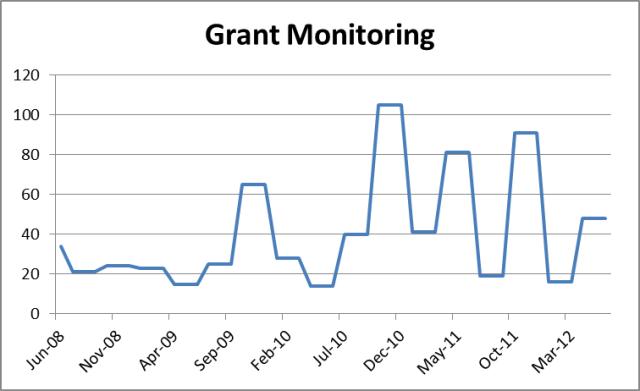 The two measures below are used to administer the Law Enforcement Support Account and the Justice Assistance grant. They are direct indicators of law enforcement activity in drug and crime enforcement. They are used to demonstrate project activity resulting from grant funding appropriated by the Utah Legislature to support drug enforcement throughout the state. 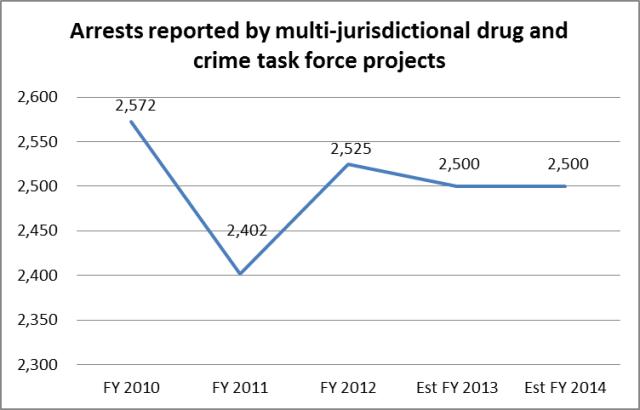
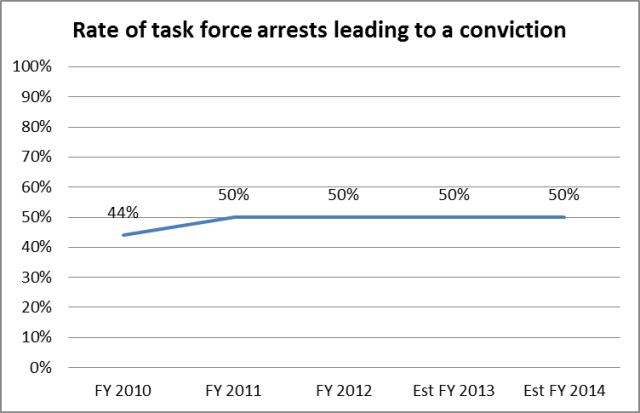 Funding Detail
Program: Utah Office for Victims of Crime Function The Utah Office for Victims of Crime (UOVC) carries out its mission in four ways; 1) Providing financial assistance to victims of violent crime; 2) Managing federal grants that serve victims of crime; 3) Sponorship of the Utah Victim Assistance Acadamy; and 4) Providing staffing assistance to the Utah Council on Vctims of Crime. These four duties are explained further in the paragraphs below. Financial Assistance to Victims of Violent Crime. UOVC provides short-term assistance with needs such as medical bills, mental health counseling, funeral and burial in homicide cases, and relocation. Since its inception in 1987, UOVC has provided over $14.5 million in assistance to over 84,000 crime victims. All funds come directly from convicted offenders as UOVC receives no tax dollars to fund its operations. Federal Grants that Serve Victims of Crime. The Victim of Crime Act (VOCA) grant is sub-awarded to state and local government agencies and non-profit agencies providing direct services such as victim advocacy, crisis intervention, assistance with protective orders, and counseling services. The Violence Against Women Act (VAWA) grant encourages enhancement of effective strategies to improve the system's response to violence against women. Sponsorship of the Utah Victim Assistance Academy. A week-long training for victim assistance providers, law enforcement officers, and other criminal justice professionals. The goal of the academy is to provide fundamental knowledge and skills needed to effectively work with victims of crime. The academy is funded through a federal grant. UOVC further provides statewide training on current trends and issues relevant to victim advocacy through the Statewide Association of Victim Advocates, SWAVO. Utah Council on Victims of Crime. UOVC provides staffing assistance to the council and administers the contract for the Victim Information and Notification Everyday (VINE) program presently housed in all twenty-six county jails and the Utah State Prison. Total monthly contacts to victims through the VINE network for 2012 averaged about 34,303. Statutory Authority Statutory authority for this program is located in UCA 63M Chapter 7 Part 5, "Utah Office for Victims of Crime." Intent Language
Performance
The Office for Victims of Crimes measures the time required to process new claims from application to determination and has tracked the percent of claims processed within 30 days for many years. Previously this measure included both approved and denied claims. While including "denied" claims in the calculation simplifies the measurement and explanation, it does not reflect OVC's commitment to victims. The office continues to work with applicants until all legitimate claims are processed and does not impose an artificial deadline on the application timeline. The new measure includes claims approved within 30 days which continues to hold the office accountable to quickly resolve problems and yet better reflects OVC's commitment to service. 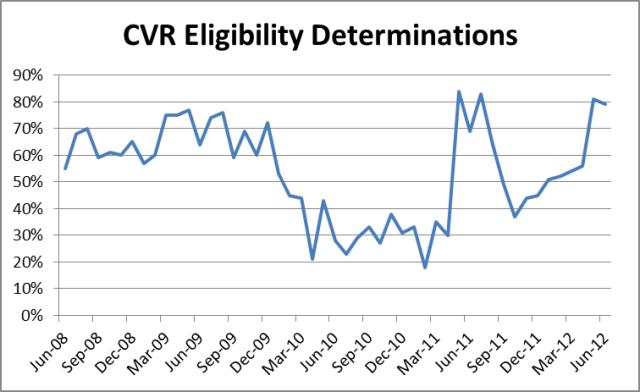 This is a workload measure and it is used to administer the Crime Victims Reparations Account. 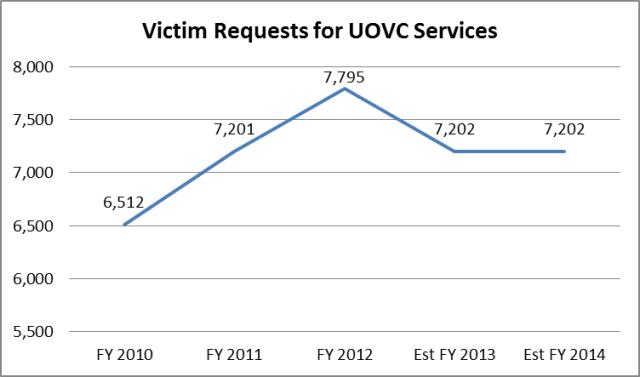 This is a workload measure and it is used to administer the Crime Victims Reparations Account. 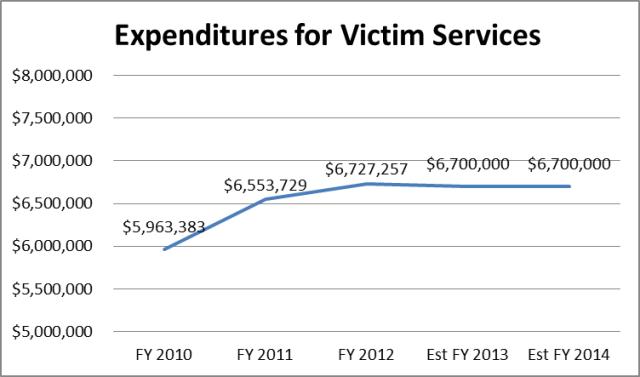 This is a workload measure and is used to demonstrate project activity resulting from federal grant funding.  Special Funds The Crime Victim Reparations Fund is a restricted special revenue fund, meaning it does not require an appropriation for most expenditures. However, the office historically seeks appropriations for expenditures on program administration. Funding Detail No state tax dollars are used to fund the Victim Reparation program. During the 2012 General Session an exception to this was made by the Legislature through a one-time General Fund appropriation of $150,000. The accompanying intent language for this appropriation is included above and provides further detail as to its purpose. Expenditures from the Crime Victim Reparations Fund may include reparations for victims, funding for other victim services, and administrative costs for the UOVC and the Utah Commission on Criminal and Juvenile Justice as appropriated by the Legislature.
Function The Extraditions program is responsible for paying the travel-related costs of prisoner extraditions from other states and countries to Utah. Such payments are authorized by law and typically include travel, lodging, and meals for the officers and the prisoner. The officers' salaries are paid by the jurisdiction requesting the extradition. Statutory Authority Statutory authority for payment of extradition costs is located in UCA 77-30-24. Performance
The three performance measures below are used to administer the extraditions account. They are used to track expenditures, plan, and make requests to the Legislature. They indicate total cost to the state for felony extraditions. 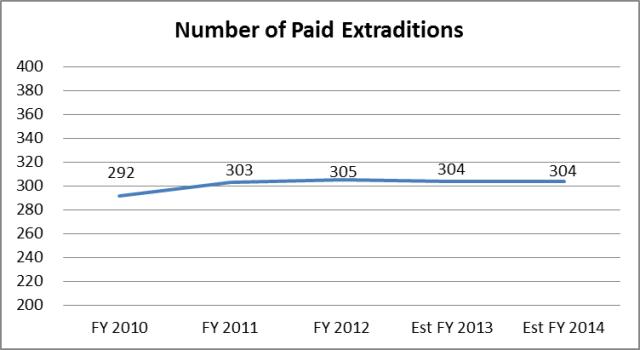
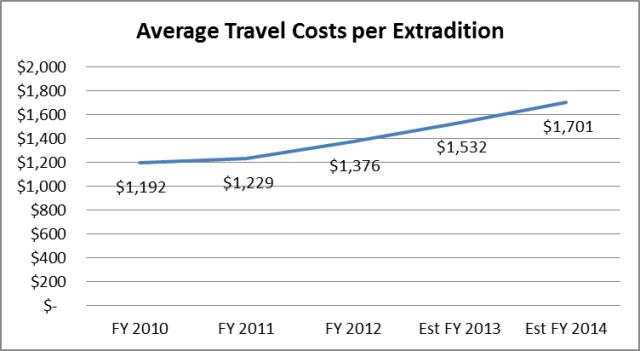
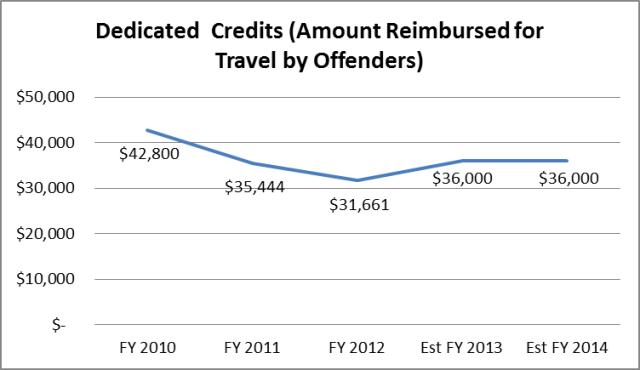 Funding Detail
Program: Substance Abuse Advisory Council Function The Utah Substance Abuse Advisory Council (USAAV) was established to provide leadership, promote collaboration, and generate unity for Utah's efforts to address issues related to substance abuse. The council consists of 28 members. The mission of the council is to create and coordinate a comprehensive strategy to eliminate substance abuse throughout Utah. The council reports annually to the Governor, Legislature, Judicial Council, and CCJJ. USAAV is currently facilitating coordination of efforts targeted at: Statutory Authority Statutory authority for this program is located in UCA 63M Chapter 7 Part 3, "Utah Substance Abuse Advisory Council." Performance
This workload measure is used to gauge if DORA is serving the projected number of eligible felony offenders in each area receiving funding. It is utilized to determine if DORA is operating at capacity and as effectively as possible within existing funding parameters. The goal it is tied to is derived from UCA 63M-7-303 (1)(b): recommend and coordinate the creation, dissemination, and implementation of a statewide substance abuse policy. 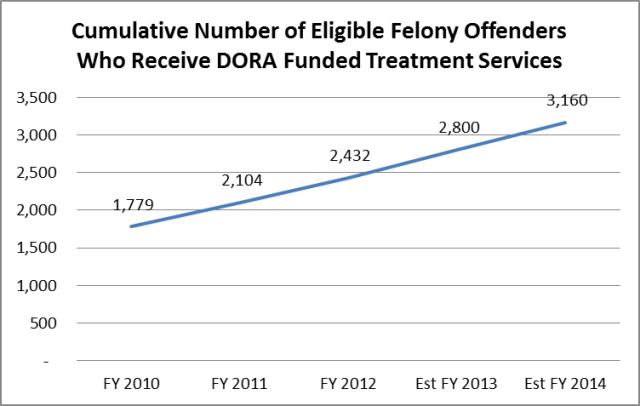 This measure assists the USAAV DUI Committee in determining the need for statutory changes, as well as improvements to the criminal history information sharing system that will help to hold DUI offenders accountable for their crimes. It helps determine the effectiveness of USAAV DUI Committee recommendations regarding statutory changes and improvements to criminal justice system information sharing/coordination. The goal it is tied to is derived from UCA 32B-2-306: Oversee underage drinking prevention media and education campaign 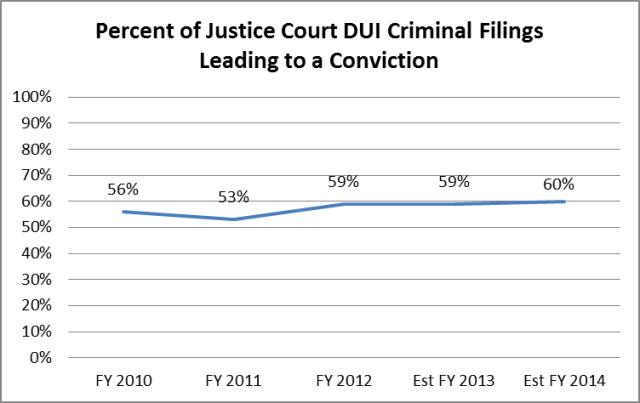 This measure is based on a biennial survey and data is available in odd years only. It is is an outcome measure and it helps determine the impact and effectiveness of the Parents Empowered Underage Drinking Prevention Campaign in preventing and reducing underage drinking in Utah. It is used to identify strengths and weaknesses in the campaign and to inform the development of future campaign materials. 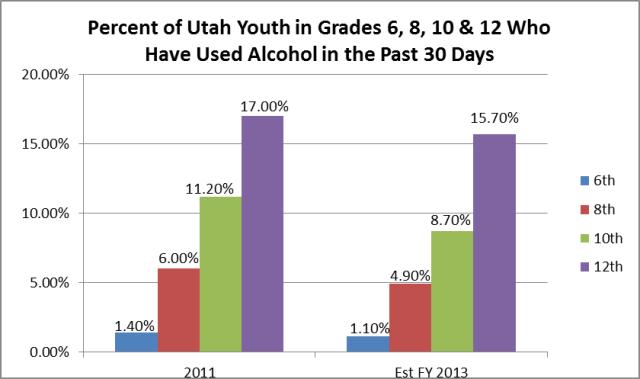 Funding Detail
Program: Sentencing Commission Function The Sentencing Commission is charged with establishing sentencing and release guidelines and recommending sentencing and release policy for both juvenile and adult offenders. The commission fulfills these duties with an understanding that the primary purposes of sentencing are to protect and compensate the victim and society, punish the offender, and reduce the likelihood of future crimes by the offender through rehabilitation or incapacitation. The commission's current priority issues include policies regarding the use of risk assessments and other evidence based principles in sentencing. Statutory Authority Statutory authority for this program is located in UCA 63M Chapter 7 Part 4, "Sentencing Commission." Performance The following table was provided for the Sentencing Commission's performance measures. The table is proceeded by an explanation for each measure.  This is a workload measure of the commission's statutory charge to publish Adult Sentencing and Release Guidelines. It encompasses and is a reference for the analysis and all recommendations of the commission regarding the sentencing and release of adult offenders. Track and revise Juvenile Sentencing and Release Guidelines This is a workload measure of the commission's statutory charge to publish Juvenile Sentencing and Release Guidelines. It encompasses and is a reference for the analysis and all recommendations of the commission regarding the sentencing and release of juvenile offenders. Agreement with guidelines This is a workload measure of the reflectiveness and usefulness of the guidelines published by the commission. It is used to evaluate guidelines published by the commission and guide recommended changes. The ability to use data to guide the work of th commission ensures that the commission's work and recommendations are reliable and in the interest of public safety and reflective of good public policy. Funding Detail
Program: Gang Reduction Grant Program Function CCJJ administers the Gang Reduction Grant to address gang issues throughout the State. Emphasis is given to reducing gang related crime through community programs. Gang reduction efforts focus on early intervention programming for high-risk, gang involved youth. Two efforts the Gang Reduction Grant Program is making to meet department goals and objects include: 1) Soliciting and funding gang reduction programs across the state, and 2) Monitoring program compliance and activities. Soliciting and funding gang reduction programs across the state. A request for proposals was released in 2011 inviting state and local governmental agencies, non-profit organizations, and community-based agencies to apply for funding to support gang reduction efforts. A review committee comprised of criminal justice professionals with expertise in gang prevention and intervention reviewed the applications. CCJJ makes final award determinations. In FY 2012, two large projects received a second year of continuation funding in an effort to make a positive impact on the selected communities. Both projects are assessed for efficacy by an outside evaluator. Applicants are not guaranteed continuation funding and must apply and compete each year. All projects are limited to three years of funding. The two projects are:
Juvenile Court and Juvenile Justice Services will refer 100 high risk youth involved in gang activity, ages 14-18. A steering committee of community organizations oversees youth at risk and assists in taking intervention measures. CROSS utilizes a research based model, Risk Need Responsivity (RNR), to develop an individualized case management plan. Aggression Replacement Training (ART) and/or Cognitive Behavioral Training (CBT) are provided as a core curriculum. CROSS partners with community agencies to address pro-social involvement, academic achievement, career readiness, and family involvement. Monitoring program compliance and activities. Programs are required to submit quarterly progress reports and financial status reports as well as a final report upon program completion. Staff members visit programs on an annual basis to review program files and examine financial documentation. Continuation programs are visited bi-annually. In addition, the University of Utah Criminal Justice Center will be evaluating funded projects to assess program fidelity, adherence to best practices and program outcomes. Performance The three measures below are used to demonstrate project activity resulting from grant funding appropriated by the Utah Legislature to support the reduction of gang activity in Utah. They are direct indicators of sub-grant effectiveness. The goal they are tied to is derived from UCA 63M-7-204 (7): provide analysis, accountability, recommendations, and supervision for state and federal criminal justice grant money. 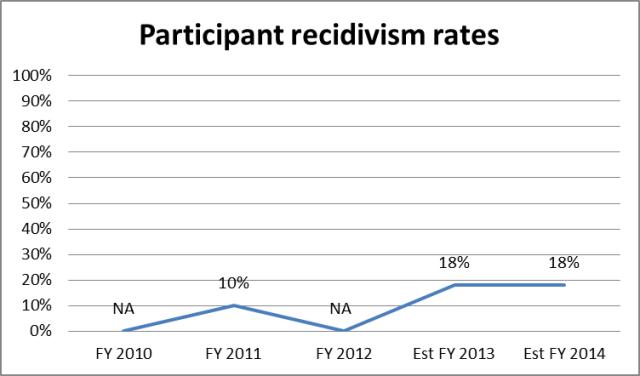 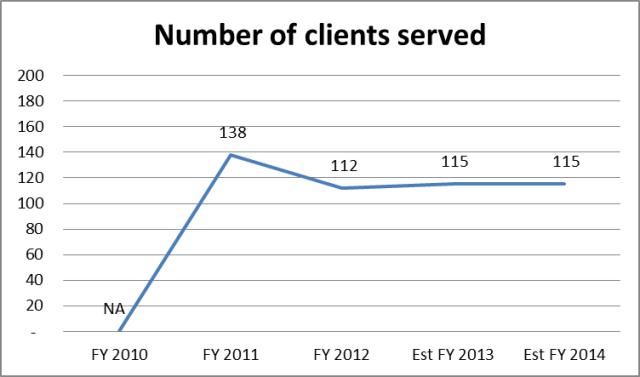
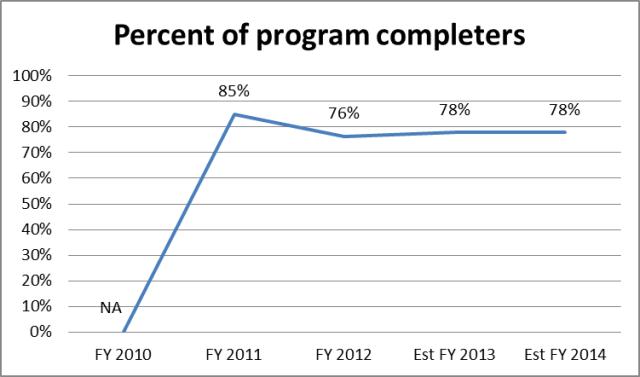 Funding Detail
Program: Crime Reduction Assistance Program Function During the 2004 General Session, the Legislature passed Senate Bill 175, "Protection of Private Lawfully Obtained Property." The bill created the Crime Reduction Assistance Program (CRA). The intent of CRA is to fund crime prevention and law enforcement activities within specific guidelines. Agencies seizing private property as a result of illegal activities direct these liquidated and forfeited assets to the Criminal Forfeiture Restricted Account (CFRA). Once funds are placed in CFRA, the Legislature may choose to appropriate the funds to CCJJ to be allocated to agencies providing drug interdiction and treatment programs. CCJJ has developed a grant program that requires recipient agencies to report back to CCJJ on how the funds were used. CCJJ compiles the data and reports it annually to the Legislature. Statutory Authority Statutory authority for this program is located in UCA 24-1-19, "Crime Reduction Assistance Program." Performance
The following three performance measures are workload measures used to administer the SAFG account. They are used to demonstrate project activity resulting from this fund which is appropriated by the Utah Legislature from seized assets to support law enforcement throughout the state. 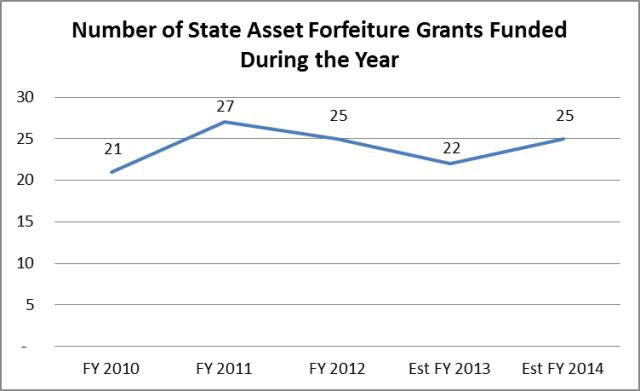
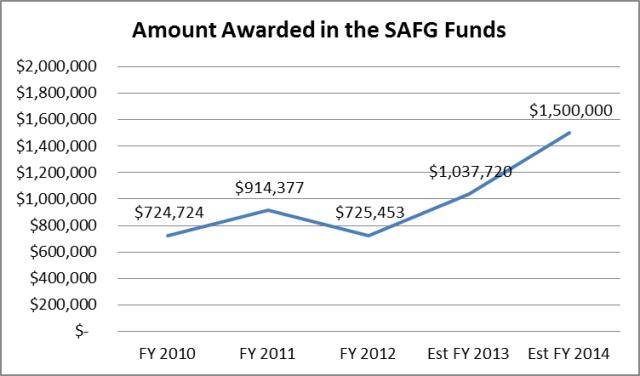 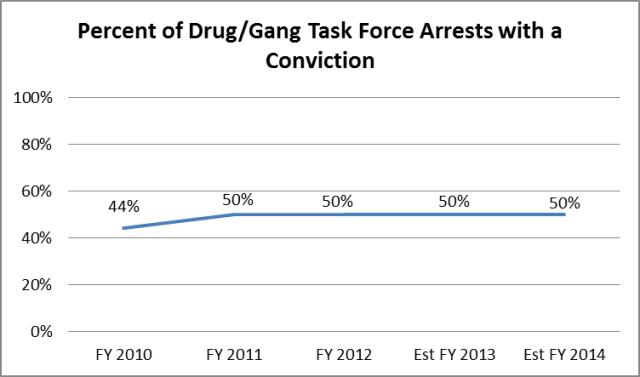 Funding Detail
Program: Sexual Exploitation of Children Function During the 2006 General Session, the Legislature passed House Bill 170, "Prosecution and Prevention of Child Pornography Offenses Amendments." Specifically, H.B. 170 amends the duties of CCJJ in Subsection 63M-7-204(13). The bill created a one-time $1 million grant program. This grant money was set aside for approved education programs which help prevent the sexual exploitation of children. In FY2007 the Utah Legislature voted to make the SECP grant an on-going program, and CCJJ is required to administer and allocate the funds. Statutory Authority Statutory authority for this program is located in UCA 63M-7-204(13). Performance One grant has been awarded this year to the Utah Education Network (UEN) for the NetSafe Utah program. NetSafe Utah is an internet safety program developed by UEN for kids K-12. It informs children, teachers, and parents on how to safely navigate the internet and other electronic communications.
The three performance measures below are efficiency measures used to administer the SECP account. They are used to demonstrate project activity resulting from this fund which is appropriated by the Utah Legislature to support the efforts of educators, students, and parents to reduce victimization throughout the state. 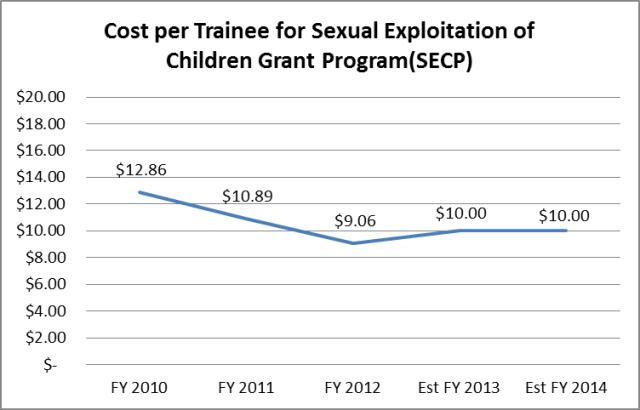
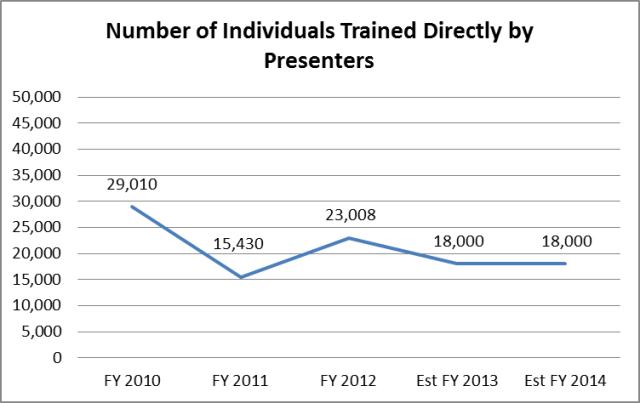
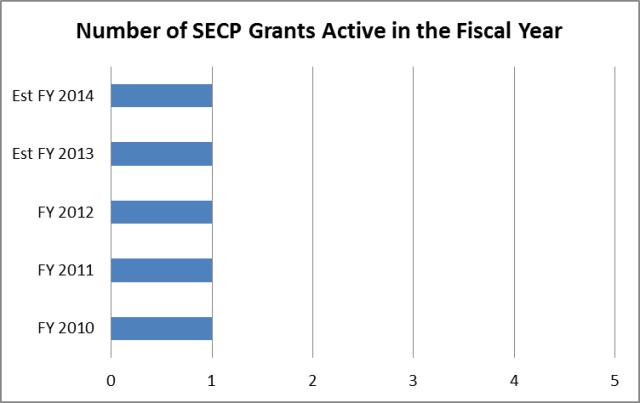 Funding Detail
Program: Judicial Performance Evaluation Commission Function The Judicial Performance Evaluation Commission collects and analyzes data on the performance of judges in Utah. The commission uses this information to prepare reports on the performance of judges standing for retention election. Summaries of these reports are published in the voter information pamphlet and on a dedicated website. The commission also makes recommendations on whether judges should be retained. Statutory Authority The commission is created in UCA 78A-12-201 with 13 members. The requirement to prepare performance evaluations begins with the 2012 judicial retention elections. The commission may consider:
Performance
This measure is tied to the statutory goal that requires JPEC to fully evaluate all of the judges standing for retention, beginning with the 2012 general election. The ultimate goal of the commission's work is to fulfill this mandate. 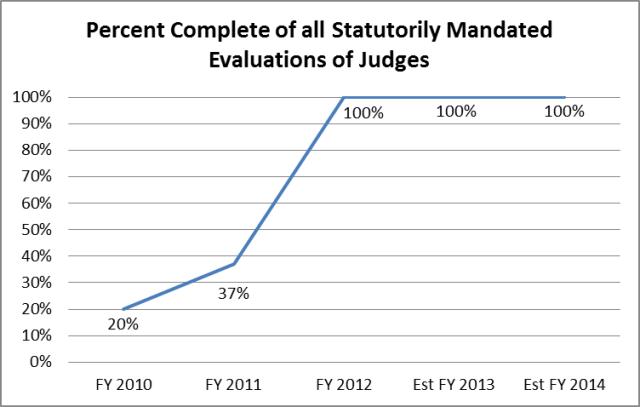 This measure is tied to the statutory goal of making the public aware of the existence of the judicial evaluation reports so that citizens can cast informed votes. JPEC must complete its report early enough to make the information available to the public before the election. Unless the public knows about JPEC's work, it will not have the resources to make informed votes about whether or not to retain judges. 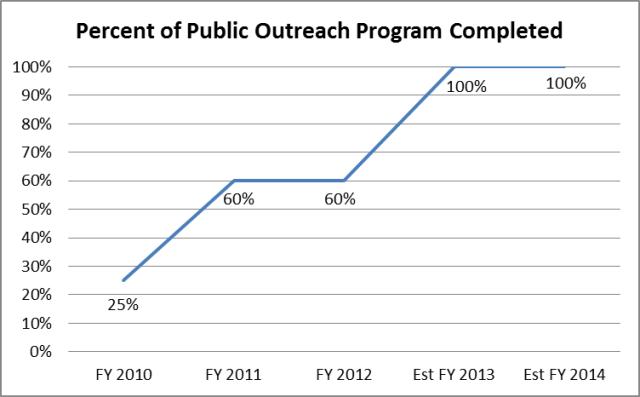 This measure is tied to the statutory goal that mandates that JPEC create a website from which citizens can access judicial evaluation reports prior to a general election. JPEC uses the website as the main portal for disseminating information about judicial performance evaluations to the public. The website must be up and running and kept up-to-date in order to provide the public with relevant information before each general election. 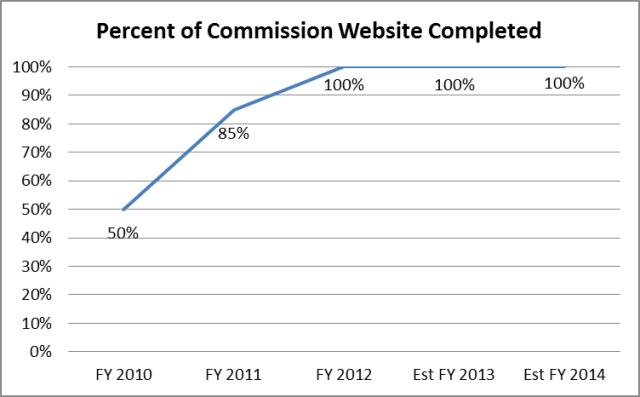 Funding Detail
| |||||||||||||||||||||||||||||||||||||||||||||||||||||||||||||||||||||||||||||||||||||||||||||||||||||||||||||||||||||||||||||||||||||||||||||||||||||||||||||||||||||||||||||||||||||||||||||||||||||||||||||||||||||||||||||||||||||||||||||||||||||||||||||||||||||||||||||||||||||||||||||||||||||||||||||||||||||||||||||||||||||||||||||||||||||||||||||||||||||||||||||||||||||||||||||||||||||||||||||||||||||||||||||||||||||||||||||||||||||||||||||||||||||||||||||||||||||||||||||||||||||||||||||||||||||||||||||||||||||||||||||||||||||||||||||||||||||||||||||||||||||||||||||||||||||||||||||||||||||||||||||||||||||||||||||||||||||||||||||||||||||||||||||||||||||||||||||||||||||||||||||||||||||||||||||||||||||||||||||||||||||||||||||||||||||||||||||||||||||||||||||||||||||||||||||||||||||||||||||||||||||||||||||||||||||||||||||||||||||||||||||||||||||||||||||||||||||||||||||||||||||||||||||||||||||||||||||||||||||||||||||||||||||||||||||||||||||||||||||||||||||||||||||||||||||||||||||||||||||||
| <-Previous Page | Next Page-> |
COBI contains unaudited data as presented to the Legislature by state agencies at the time of publication. For audited financial data see the State of Utah's Comprehensive Annual Financial Reports.